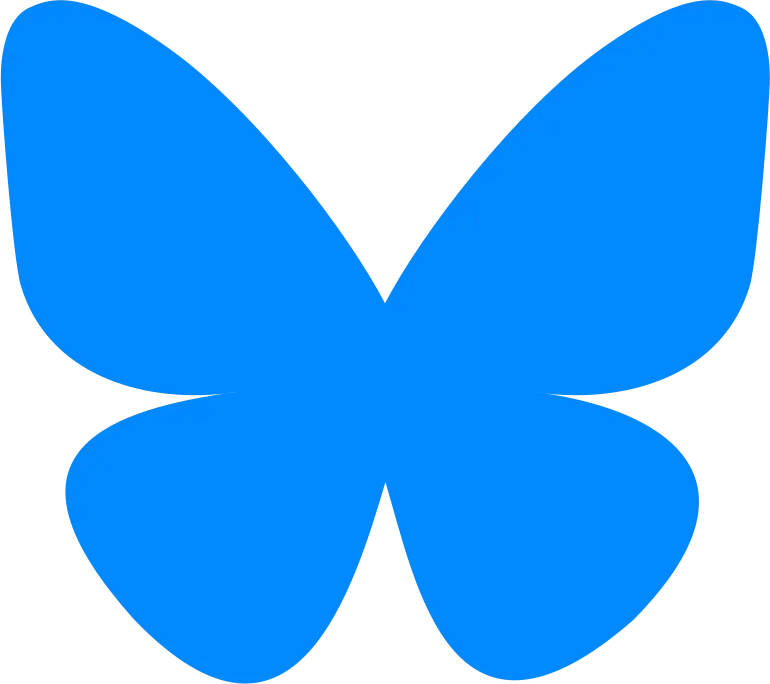About me

Welcome! I am a radio astronomer at Durham University. In my research, I focus on the effect that supermassive black holes have on the formation and evolution of galaxy clusters. In particular, I primarily study the radio properties of these black hole systems, which reveal how these black holes heat up the cluster environment and affect the formation of new stars.
Observationally, I specialize in high-resolution radio observations taken at low frequencies, and am therefore a member of the LOFAR Surveys KSP Collaboration and the Square Kilometer Array VLBI Science Working Group. Within these collaborations, I contribute to the development of calibration strategies and software, which have resulted in multiple observational breakthroughs.
Prior to my current position at Durham University, I obtained my PhD at Leiden Observatory. Before that, I studied at the University of Groningen.
Please feel free to contact me via email at roland.timmerman  durham.ac.uk
durham.ac.uk
Are you a student or teacher?
When I was a student with a passion for space and astronomy, I had no idea you could just contact professional academics, but you absolutely can! If you're a student or teacher and if there's anything I can do for you, please feel free to reach out! I would love to help out in any way I can, including interviews, supervision of projects including perhaps some real astronomical data, or even just answering a quick question. Your email is very welcome :)
Recent work
New high-resolution radio images of galaxy clusters made with LOFAR
Following the release of the new LOFAR-VLBI pipeline, we published a series of high-resolution radio maps of active galactic nuclei in galaxy clusters. Notably, these maps beautifully show the interaction between the magnetized plasma orginating from the central AGN (shown here in red) with the surrounding intracluster medium (shown in blue). Thanks to these new observations, we are able to measure the total energy output of these AGNs in more detail, helping us understand how galaxy clusters form. Currently, we are working on using these new observational capabilities to study these systems in the Early Universe.
Our paper on these results was published in the peer-reviewed journal Astronomy & Astrophysics.
 (c) LOFAR/Chandra/WIYN/Hubble/Frits Sweijen/Roland Timmerman
(c) LOFAR/Chandra/WIYN/Hubble/Frits Sweijen/Roland Timmerman
 (c) LOFAR/Hubble/Roland Timmerman
(c) LOFAR/Hubble/Roland Timmerman
Deep radio observations of galaxy clusters in the Early Universe
Following up on our previous project in the nearby Universe, we received 50 hours of LOFAR observing time on a sample of high-redshift galaxy clusters. Using the resulting images, we are able to study the effect supermassive black holes have on the formation and evolution of galaxy clusters. The example shown here, with the 144 MHz radio emission shown in red, shows part of a galaxy cluster at less than half the current age of the Universe. Two radio lobes formed by jetted outflows from the central supermassive black hole are shown to shoot out of their galaxy and into the cluster environment. These are some of the most distant radio lobes ever observed with such rich detail.
Our paper on these results was published in the peer-reviewed journal Astronomy & Astrophysics.
Collaboration highlights
Porphyrion: the discovery of a record-breaking Giant Radio Galaxy
Our team, led by Martijn Oei, discovered the radio galaxy Porphyrion in the LOFAR Two-Metre Sky Survey. This radio galaxy, spanning 7 megaparsecs or approximately 140 times the diameter of our Milky Way galaxy, has broken the previous record of Alcyoneus (also a discovery of Oei et al.). Notably, Porphyrion is the first known radio galaxy to reach scales comparable to the size of voids of the Cosmic Web, implying that there is not a single location in the Universe isolated enough to be free from the impact of black hole feedback. With deeper surveys and next-generation instruments, we will try to learn if Porphyrion is unique, or if it just the tip of the iceberg...
Our paper on these results was published in Nature.
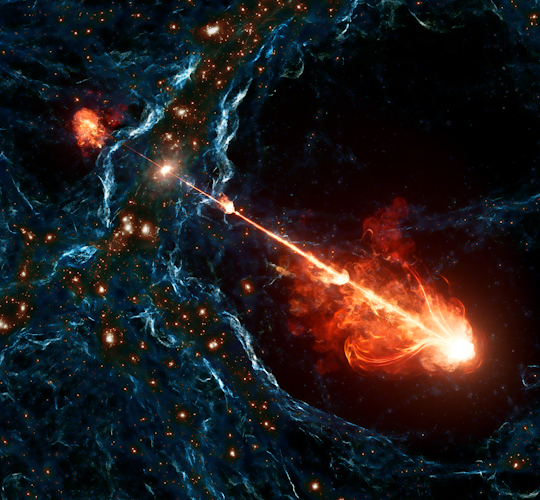 (c) E. Wernquist/M. Oei/D. Nelson/IllustrisTNG Collaboration
(c) E. Wernquist/M. Oei/D. Nelson/IllustrisTNG Collaboration
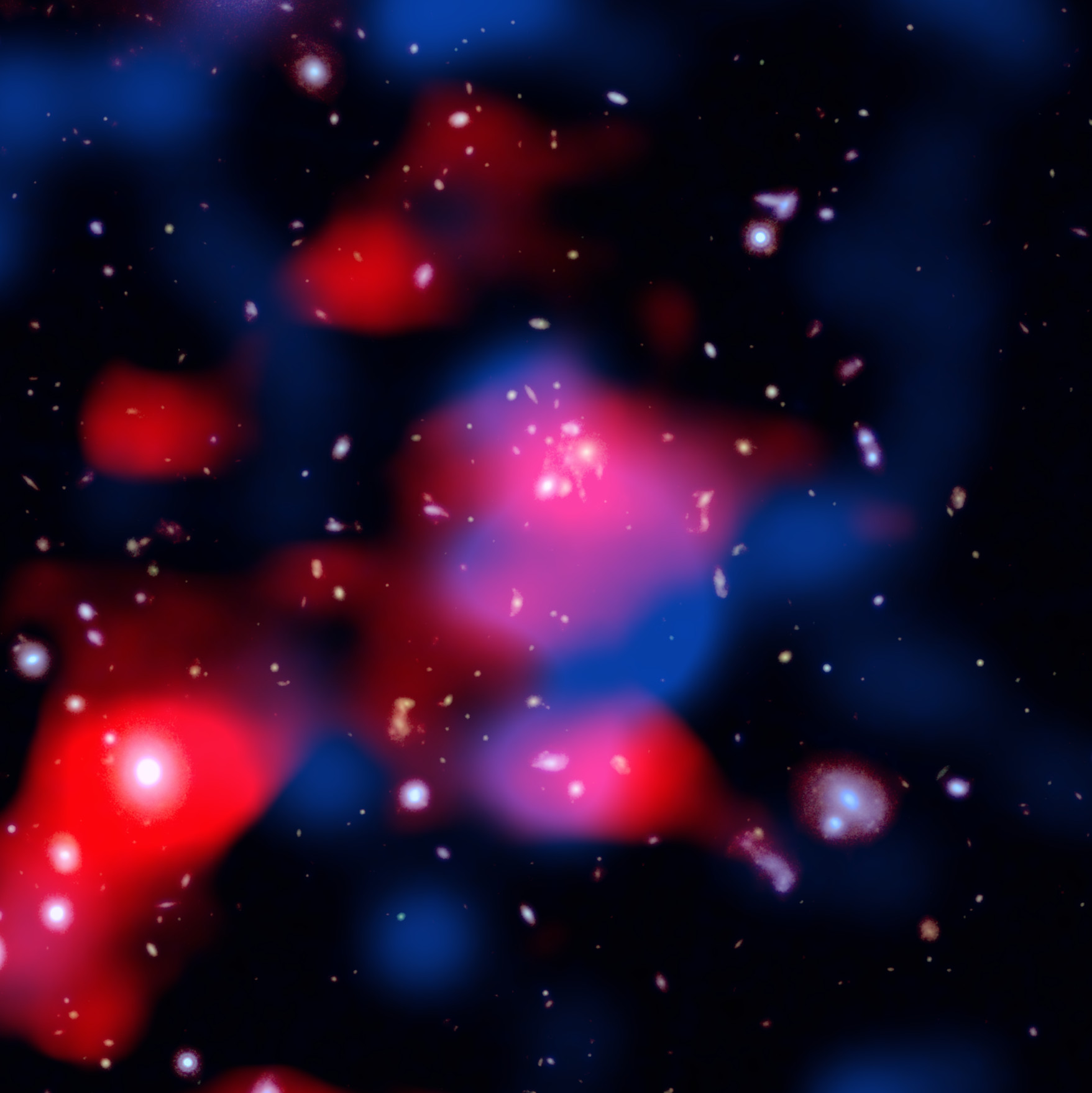 (c) X-ray: NASA/CXC/SAO; Optical: NASA/ESA/STScI; Radio: ASTRON/LOFAR; Image Processing: NASA/CXC/SAO/N. Wolk
(c) X-ray: NASA/CXC/SAO; Optical: NASA/ESA/STScI; Radio: ASTRON/LOFAR; Image Processing: NASA/CXC/SAO/N. Wolk
An Ancient Sea of Cosmic Rays: the Mini-Halo in SpARCS1049
Our team, led by Julie Hlavacek-Larrondo, discovered a mini-halo in the distant cool-core galaxy cluster SpARCS1049. Remarkably, this galaxy cluster is located at a staggering redshift of over 1.7, which is over double the previous record! These mini-halos are essentially a diffuse cloud of cosmic ray particles that permeate the central cluster environment. Research is currently ongoing to understand how highly energetic cosmic rays were able to end up in the middle of "empty" space to produce a mini-halo. The formation of such a mini-halo this early in the history of the Universe therefore also has major implications on how galaxy clusters form and what the environment of galaxies looked like in the early Universe.
Our paper on these results was published in Astrophysical Journal Letters.
Ongoing projects
The High Resolution reprocessing of the LOFAR Two-Metre Sky Survey (LoTSS-HR)

I co-lead an exciting project where we follow up the LOFAR Two-Metre Sky Survey (LoTSS) using our new VLBI data calibration pipeline. This allows us to improve upon the angular resolution of LoTSS by a factor of 20. This increased angular resolution reveals the detailed structure of many radio sources for the first time. An example of a LoTSS field we processed is shown above, where the zoomed-in panels display the new LoTSS-HR results. Per field, we image on the order of 100 sources, and in total we aim to process on the order of 1000 fields. All of these results will soon be published through data releases, making high-resolution LOFAR images easily available to the community for the first time!
Code highlights
Radio image redshifter
Understanding the observational biases that affect measurements at different redshifts can be challenging. However, by being able to virtually place a radio source at a different distance, it is possible to gain some critical first-order insight. To do this as accurately as possible, I have written a Python code that rescales the radio map using the CLEAN model components based on the angular diameter and luminosity distances, and the integrated spectral index. Finally, the rescaled CLEAN model is convolved with the beam and either the original CLEAN residual map or a random Gaussian noise map is added. The resulting image then provides the best estimate of what the source would look like if it were at a different redshift.
All relevant Python code is available on my GitHub.
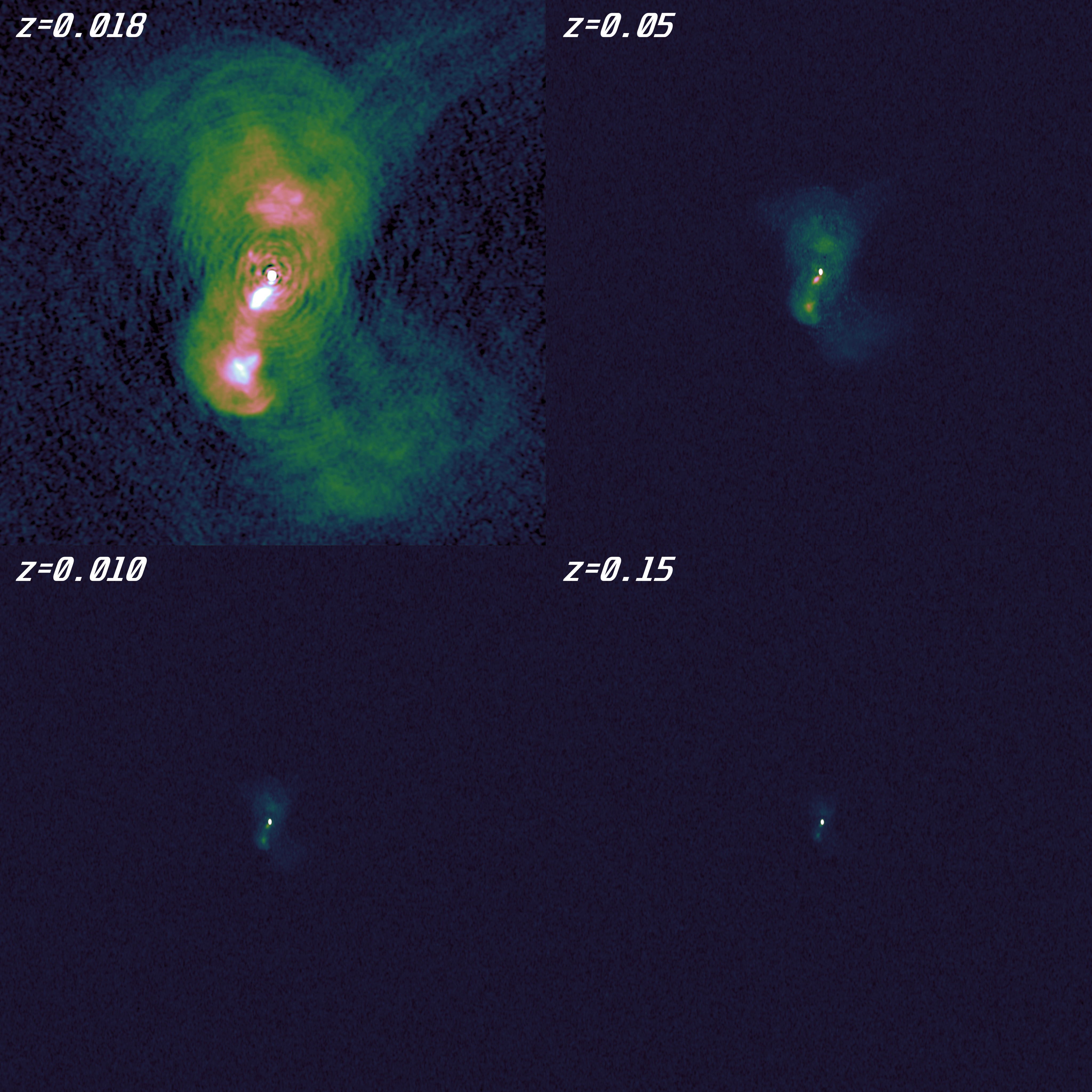 (c) LOFAR/Roland Timmerman
(c) LOFAR/Roland Timmerman
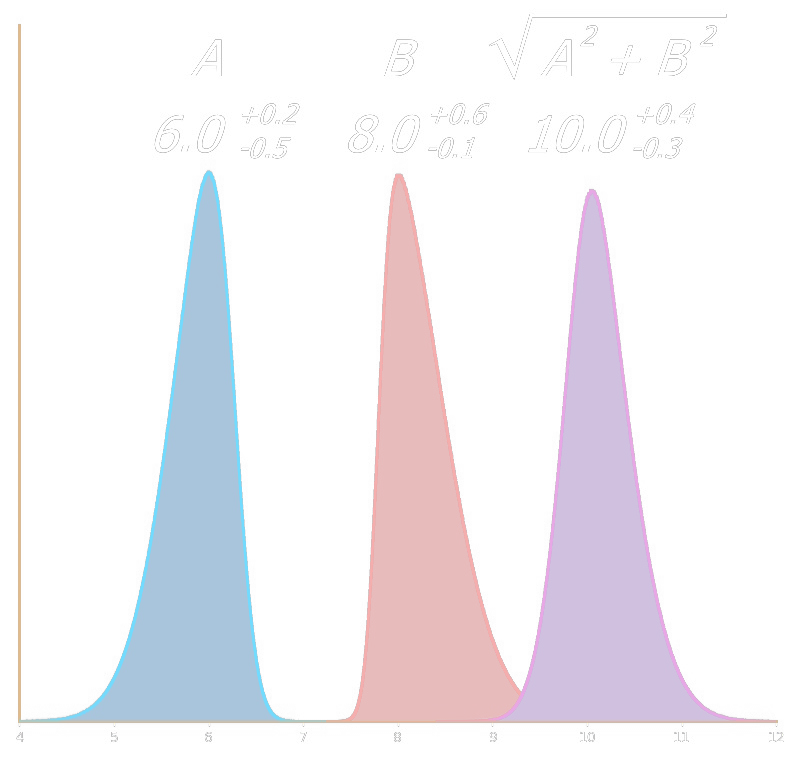 (c) Roland Timmerman
(c) Roland Timmerman
Asymmetric uncertainty Monte Carlo
Determining accurate uncertainties is a key part of any scientific measurement. Monte Carlo approaches provide a robust strategy to estimate the uncertainty on the output of arbitrarily complex mathematical operations. A subtle but fundamental step of such an approach is generating random samples according to a representative distribution, such as a normal distribution. However, especially when different quantities relate to each other in non-linear ways, uncertainties can become asymmetric. This makes it difficult to use values reported in literature while maintaining the correct uncertainties. To resolve this, I have written a Python code to generate random samples according to a skewed normal distribution, defined simply by the best value and the uncertainties on that value.
All relevant Python code is available on my GitHub.
Publications
LOFAR Non-detections of SN 2023ixf in its First Year Post-explosion
R. Timmerman, M. Arias, and A. Botteon
Research Notes of the AAS, 2024, 8, 311
The first high-redshift cavity power measurements of cool-core galaxy clusters with the International LOFAR Telescope
R. Timmerman, R. J. van Weeren, A. Botteon, H. J. A. Röttgering, L. K. Morabito and F. Sweijen
Astronomy & Astrophysics, 2024, 687, A31
Measuring cavity powers of active galactic nuclei in clusters using a hybrid X-ray-radio method
R. Timmerman, R. J. van Weeren, A. Botteon, H. J. A. Röttgering, B. R. McNamara, F. Sweijen, L. Bîrzan and L. K. Morabito
Astronomy & Astrophysics, 2022, 668, A65
Origin of the ring structures in Hercules A
R. Timmerman, R. J. van Weeren, J. R. Callingham, W. D. Cotton, R. Perley, L. K. Morabito, N. A. B. Gizani, A. H. Bridle, C. P. O'Dea, S. A. Baum, G. R. Tremblay, P. Kharb, N. E. Kassim, H. J. A. Röttgering, A. Botteon, F. Sweijen, C. Tasse, M. Brüggen, J. Moldon, T. Shimwell and G. Brunetti
Astronomy & Astrophysics, 2022, 658, A5
Very Large Array observations of the mini-halo and AGN feedback in the Phoenix cluster
R. Timmerman, R. J. van Weeren, M. McDonald, A. Ignesti, B. R. McNamara, J. Hlavacek-Larrondo and H. J. A. Röttgering
Astronomy & Astrophysics, 2021, 646, A38


